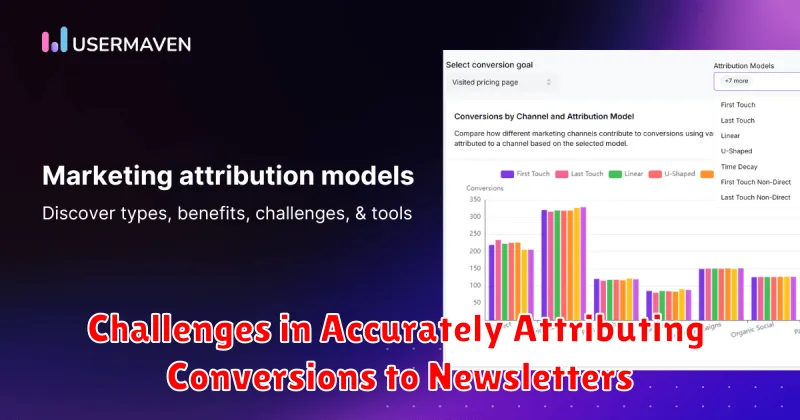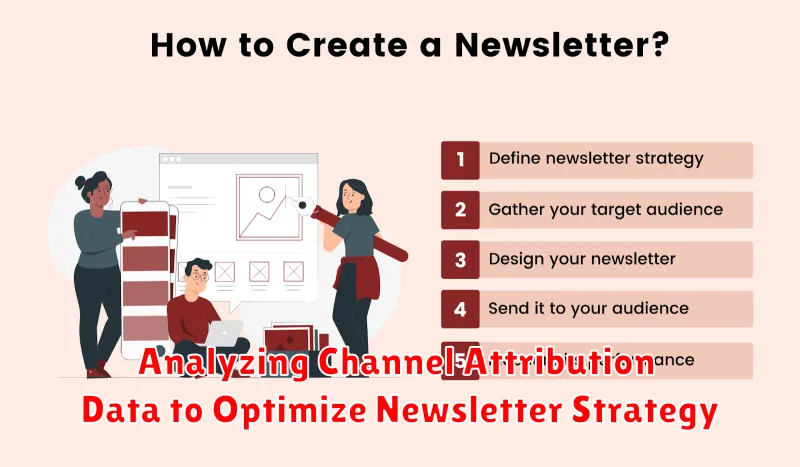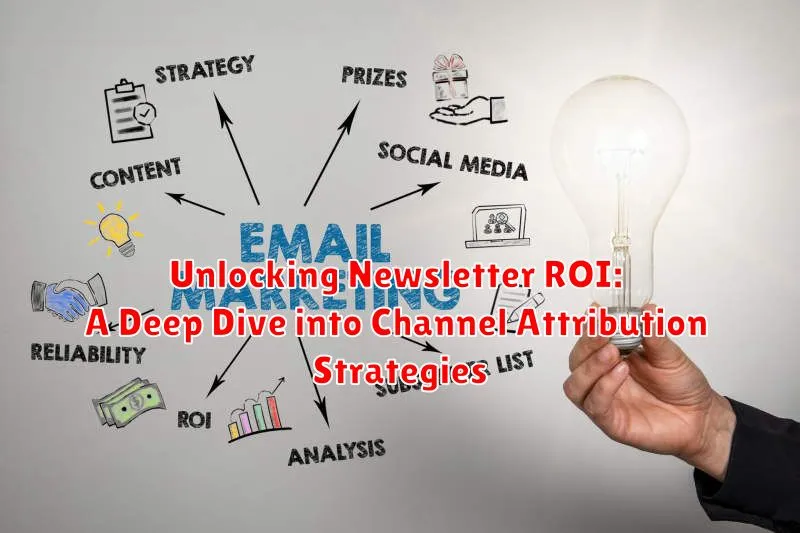In today’s digital landscape, email newsletters remain a powerful tool for businesses to engage with their audience, nurture leads, and drive conversions. However, simply sending out newsletters is not enough. Understanding the return on investment (ROI) of your newsletter efforts is crucial for optimizing your strategy and maximizing its impact. This necessitates a deep dive into channel attribution strategies, enabling you to accurately track which touchpoints are contributing to your desired outcomes. This article aims to provide a comprehensive overview of the methods and best practices for unlocking the true ROI of your email marketing campaigns through effective attribution modeling.
Many marketers struggle to precisely pinpoint the influence of their newsletter on overall business performance. Are subscribers converting directly from the email, or is the newsletter a valuable touchpoint in a longer customer journey? By implementing robust channel attribution strategies, you can gain invaluable insights into the effectiveness of your email marketing. This exploration will cover various attribution models, from first-touch and last-touch to more sophisticated multi-touch approaches, and provide guidance on selecting the most appropriate model for your specific business objectives. We will also discuss the importance of data collection, analysis, and reporting in accurately measuring the ROI of your newsletter and optimizing your email marketing spend.
What is Channel Attribution and Why Does It Matter for Newsletters?
Channel attribution is the process of identifying which marketing channels are responsible for driving conversions or desired outcomes. It involves assigning credit to different touchpoints a customer interacts with on their path to purchase or engagement. In essence, it’s about understanding which channels influenced a user before they took a specific action.
For newsletters, channel attribution is particularly important because it helps marketers understand the true value of their email marketing efforts. It moves beyond simply tracking opens and clicks, and delves into how newsletters contribute to overall business goals, such as website visits, lead generation, and sales. Without proper attribution, it’s difficult to justify newsletter marketing spend or optimize campaigns for maximum ROI.
Why does it matter? Because understanding which referral sources send engaged leads can improve your return on ad spend. For example, consider two scenarios:
- Scenario 1: Newsletter driving direct sales
- Scenario 2: Newsletter contributing to brand awareness, leading to search engine conversions later.
Channel attribution allows one to measure both scenarios so campaigns can be appropriately incentivized to maximize your return on investment.
Common Channel Attribution Models Used for Newsletter Campaigns
Several channel attribution models can be employed to understand how newsletters contribute to conversions. Each model assigns credit differently across the customer journey, offering unique insights.
First-Touch Attribution
This model gives 100% credit to the first touchpoint a customer interacts with. If a user subscribes to the newsletter via a specific ad and later converts, that ad receives full credit.
Last-Touch Attribution
Conversely, last-touch attribution attributes the entire conversion to the final touchpoint. If a customer clicks a link in the newsletter and then purchases, the newsletter gets full credit.
Linear Attribution
The linear model distributes credit evenly across all touchpoints in the customer journey. If there are five touchpoints, each receives 20% credit.
Time-Decay Attribution
This model gives more credit to touchpoints closer to the conversion. Touchpoints that occurred further in the past receive less credit.
U-Shaped (Position-Based) Attribution
The U-shaped model attributes the majority of the credit (e.g., 40% each) to the first and last touchpoints, with the remaining 20% distributed among the other touchpoints.
Challenges in Accurately Attributing Conversions to Newsletters

Accurately attributing conversions to newsletters presents several challenges. One primary obstacle is the complexity of the customer journey. Users often interact with multiple marketing channels before converting, making it difficult to isolate the newsletter’s specific contribution.
Cookie limitations and privacy regulations also impede accurate tracking. As third-party cookies become less reliable, accurately attributing conversions solely based on click-through data becomes increasingly problematic.
Furthermore, cross-device tracking introduces another layer of complexity. Users may open a newsletter on their mobile device but complete the purchase on their desktop, making it challenging to connect these touchpoints without robust tracking mechanisms.
Finally, delayed conversions pose a significant challenge. A user might subscribe to a newsletter, wait for a specific promotion, and then convert weeks or months later. Attributing this delayed conversion directly to the original newsletter interaction requires sophisticated attribution models and long-term data tracking.
Best Practices for Implementing Channel Attribution for Newsletters
Implementing effective channel attribution for newsletters requires a strategic approach. Clearly define your conversion goals, such as website visits, purchases, or sign-ups. Subsequently, establish a consistent UTM parameter structure for all newsletter links to track the source, medium, campaign, and content. This allows for granular data collection.
Employ a suitable attribution model aligned with your business objectives. Consider models like first-touch, last-touch, linear, time-decay, or position-based to determine how credit is distributed across various touchpoints. Regularly audit your data collection process to ensure accuracy and identify any discrepancies or missing information. It is crucial to maintain data hygiene for reliable reporting.
Integrate your newsletter platform with your analytics tools (e.g., Google Analytics) and CRM system to centralize data and gain a comprehensive view of the customer journey. Finally, document your attribution methodology and train your team on its implementation to maintain consistency and clarity throughout the organization.
Tools and Technologies for Effective Newsletter Attribution
Effective newsletter attribution relies heavily on the right tools and technologies. Selecting the appropriate platform can significantly enhance your ability to accurately track and analyze campaign performance.
Key Tool Categories:
- Email Marketing Platforms: Platforms like Mailchimp, Klaviyo, and Sendinblue offer built-in tracking features, including UTM parameter generation and basic conversion tracking.
- Analytics Platforms: Google Analytics is crucial for tracking website traffic originating from your newsletters. Integrating it with your email platform allows you to monitor user behavior after they click through.
- Attribution Software: Specialized attribution tools, such as Ruler Analytics or Bizible, provide more sophisticated multi-touch attribution models, helping you understand the complete customer journey.
- CRM Integration: Connecting your CRM (e.g., Salesforce, HubSpot) allows you to tie newsletter engagement to lead scoring and sales conversions.
Consider factors such as integration capabilities, pricing, and reporting features when choosing your attribution tools.
How to Track Newsletter Performance Using UTM Parameters
UTM (Urchin Tracking Module) parameters are essential for tracking newsletter performance by providing granular insights into traffic sources. These parameters are added to the end of your newsletter links, allowing you to identify which campaigns, sources, and mediums are driving conversions.
Here’s a breakdown of common UTM parameters:
- utm_source: Identifies the source of your traffic (e.g., newsletter).
- utm_medium: Identifies the marketing medium (e.g., email).
- utm_campaign: Identifies a specific product promotion or campaign (e.g., summer_sale).
- utm_term: Identifies the search terms (often used in paid search campaigns).
- utm_content: Used to differentiate ads or links that point to the same URL (e.g., different banner ads within the same email).
By using UTM parameters consistently, you can effectively track which newsletter campaigns are most successful in driving traffic, conversions, and ultimately, ROI.
The Impact of Subscriber Engagement on Channel Attribution
Subscriber engagement significantly influences the accuracy and relevance of channel attribution for newsletters. Higher engagement rates often correlate with a clearer picture of the customer journey and the newsletter’s role within it.
Low engagement (e.g., low open rates, click-through rates) can obscure the true impact of the newsletter, making it difficult to accurately attribute conversions. Subscribers who barely interact with the content might still be influenced indirectly, but this is harder to quantify.
Factors influencing engagement include:
- Content Relevance: Tailoring content to subscriber interests.
- Email Frequency: Striking a balance between staying top-of-mind and overwhelming subscribers.
- Call to Action Effectiveness: Clear and compelling calls to action that drive desired behaviors.
Improved engagement provides more data points (clicks, shares, replies) allowing for more robust attribution modelling. Increased data enables marketers to refine their understanding of how newsletters contribute to the overall marketing funnel and customer conversion process.
Analyzing Channel Attribution Data to Optimize Newsletter Strategy

The analysis of channel attribution data is paramount to refining your newsletter strategy and maximizing ROI. This process involves scrutinizing the performance of each touchpoint in the customer journey to understand its contribution to conversions.
Begin by identifying key performance indicators (KPIs) such as click-through rates, conversion rates, and revenue generated from newsletter recipients. Segment your audience based on demographics, engagement levels, and source channels to uncover granular insights.
Leverage attribution models, like first-click, last-click, or linear attribution, to understand the impact of different channels on the conversion path. Compare the results across these models to identify trends and potential areas for improvement.
Regularly review your attribution data to identify underperforming channels. Adjust your newsletter content, timing, and targeting based on these insights. For example, if a specific promotional offer consistently performs well through a certain channel, consider allocating more resources to that channel.
Continuously monitor and optimize your channel attribution strategy to ensure that your newsletter efforts are aligned with your business goals and that you are maximizing your return on investment.

